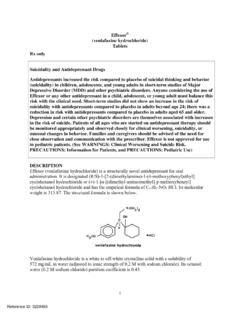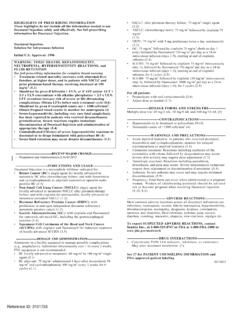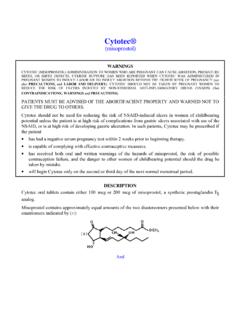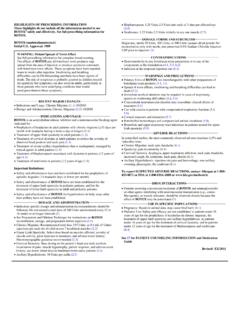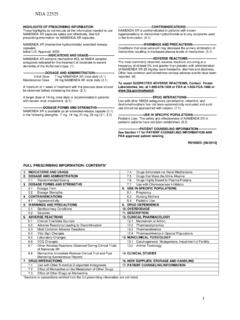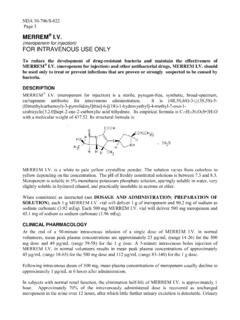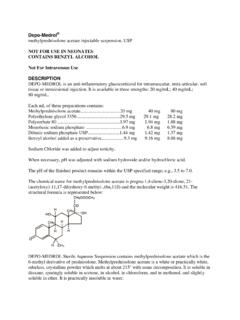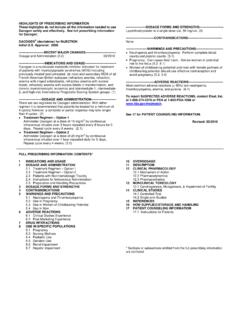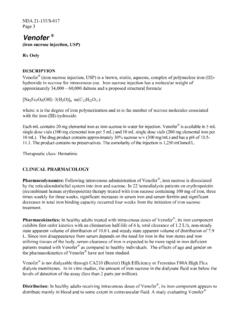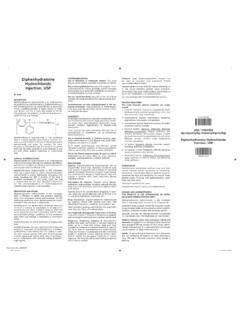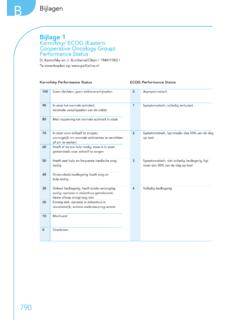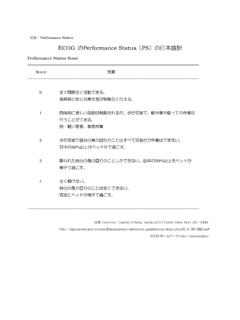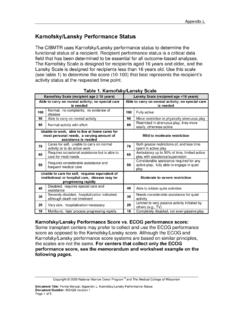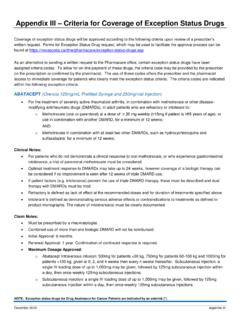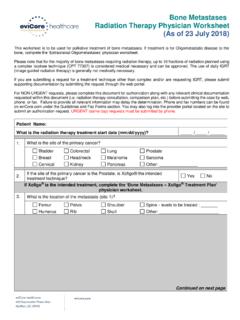Transcription of Proleukin (aldesleukin) injection label
1 Proleukin ( aldesleukin ) for injection , for intravenous infusion Rx Only WARNINGS Therapy with Proleukin ( aldesleukin ) should be restricted to patients with normal cardiac and pulmonary functions as defined by thallium stress testing and formal pulmonary function testing. Extreme caution should be used in patients with a normal thallium stress test and a normal pulmonary function test who have a history of cardiac or pulmonary disease. Proleukin should be administered in a hospital setting under the supervision of a qualified physician experienced in the use of anticancer agents. An intensive care facility and specialists skilled in cardiopulmonary or intensive care medicine must be available. Proleukin administration has been associated with capillary leak syndrome (CLS) which is characterized by a loss of vascular tone and extravasation of plasma proteins and fluid into the extravascular space.
2 CLS results in hypotension and reduced organ perfusion which may be severe and can result in death. CLS may be associated with cardiac arrhythmias (supraventricular and ventricular), angina, myocardial infarction, respiratory insufficiency requiring intubation, gastrointestinal bleeding or infarction, renal insufficiency, edema, and mental status changes. Proleukin treatment is associated with impaired neutrophil function (reduced chemotaxis) and with an increased risk of disseminated infection, including sepsis and bacterial endocarditis. Consequently, preexisting bacterial infections should be adequately treated prior to initiation of Proleukin therapy. Patients with indwelling central lines are particularly at risk for infection with gram positive microorganisms. Antibiotic prophylaxis with oxacillin, nafcillin, ciprofloxacin, or vancomycin has been associated with a reduced incidence of staphylococcal infections.
3 Proleukin administration should be withheld in patients developing moderate to severe lethargy or somnolence; continued administration may result in coma. Reference ID: 3165255 DESCRIPTION Proleukin ( aldesleukin ), a human recombinant interleukin-2 product, is a highly purified protein with a molecular weight of approximately 15,300 daltons. The chemical name is des alanyl-1, serine-125 human interleukin-2. Proleukin , a lymphokine, is produced by recombinant DNA technology using a genetically engineered E. coli strain containing an analog of the human interleukin-2 gene. Genetic engineering techniques were used to modify the human IL-2 gene, and the resulting expression clone encodes a modified human interleukin-2. This recombinant form differs from native interleukin-2 in the following ways: a) Proleukin is not glycosylated because it is derived from E.
4 Coli ; b) the molecule has no N-terminal alanine; the codon for this amino acid was deleted during the genetic engineering procedure; c) the molecule has serine substituted for cysteine at amino acid position 125; this was accomplished by site specific manipulation during the genetic engineering procedure; and d) the aggregation state of Proleukin is likely to be different from that of native interleukin-2. The in vitro biological activities of the native nonrecombinant molecule have been reproduced with ,2 Proleukin is supplied as a sterile, white to off-white, lyophilized cake in single-use vials intended for intravenous administration. When reconstituted with mL Sterile Water for injection , USP, each mL contains 18 million International Units ( mg) Proleukin , 50 mg mannitol, and mg sodium dodecyl sulfate, buffered with approximately mg monobasic and mg dibasic sodium phosphate to a pH of (range to ).
5 The manufacturing process for Proleukin involves fermentation in a defined medium containing tetracycline hydrochloride. The presence of the antibiotic is not detectable in the final product. Proleukin contains no preservatives in the final product. Proleukin biological potency is determined by a lymphocyte proliferation bioassay and is expressed in International Units as established by the World Health Organization 1st International Standard for Interleukin-2 (human). The relationship between potency and protein mass is as follows: 18 million International Units Proleukin = mg protein CLINICAL PHARMACOLOGY Proleukin ( aldesleukin ) has been shown to possess the biological activities of human native ,2 In vitro studies performed on human cell lines demonstrate the immunoregulatory properties of Proleukin , including: a) enhancement of lymphocyte mitogenesis and stimulation of long-term growth of human interleukin-2 dependent cell lines; b) enhancement of lymphocyte cytotoxicity; c) induction of killer cell (lymphokine-activated (LAK) and natural (NK)) activity; and d) induction of interferon-gamma production.
6 The in vivo administration of Proleukin in animals and humans produces multiple immunological effects in a dose dependent manner. These effects include activation of cellular immunity with profound lymphocytosis, eosinophilia, and thrombocytopenia, and the production of cytokines including tumor necrosis factor, IL-1 and gamma interferon. 3 In vivo experiments in murine tumor models have shown inhibition of tumor The exact mechanism by which Proleukin mediates its antitumor activity in animals and humans is unknown. Reference ID: 3165255 Pharmacokinetics Proleukin exists as biologically active, non-covalently bound microaggregates with an average size of 27 recombinant interleukin-2 molecules. The solubilizing agent, sodium dodecyl sulfate, may have an effect on the kinetic properties of this product.
7 The pharmacokinetic profile of Proleukin is characterized by high plasma concentrations following a short intravenous infusion, rapid distribution into the extravascular space and elimination from the body by metabolism in the kidneys with little or no bioactive protein excreted in the urine. Studies of intravenous Proleukin in sheep and humans indicate that upon completion of infusion, approximately 30% of the administered dose is detectable in plasma. This finding is consistent with studies in rats using radiolabeled Proleukin , which demonstrate a rapid (<1 min) uptake of the majority of the label into the lungs, liver, kidney, and spleen. The serum half-life (T 1/2) curves of Proleukin remaining in the plasma are derived from studies done in 52 cancer patients following a 5-minute intravenous infusion.
8 These patients were shown to have a distribution and elimination T 1/2 of 13 and 85 minutes, respectively. Following the initial rapid organ distribution, the primary route of clearance of circulating Proleukin is the kidney. In humans and animals, Proleukin is cleared from the circulation by both glomerular filtration and peritubular extraction in the This dual mechanism for delivery of Proleukin to the proximal tubule may account for the preservation of clearance in patients with rising serum creatinine values. Greater than 80% of the amount of Proleukin distributed to plasma, cleared from the circulation and presented to the kidney is metabolized to amino acids in the cells lining the proximal convoluted tubules. In humans, the mean clearance rate in cancer patients is 268 mL/min. The relatively rapid clearance of Proleukin has led to dosage schedules characterized by frequent, short infusions.
9 Observed serum levels are proportional to the dose of Proleukin . CLINICAL STUDIES Safety and efficacy were studied in a series of single and multicenter, historically controlled studies enrolling a total of 525 patients with metastatic renal cell carcinoma or melanoma. Eligible patients had an Eastern Cooperative Oncology Group (ECOG) Performance Status (PS) of 0 or 1 and normal organ function as determined by cardiac stress test, pulmonary function tests, and creatinine mg/dL. Studies excluded patients with brain metastases, active infections, organ allografts and diseases requiring steroid treatment. The same treatment dose and schedule was employed in all studies demonstrating efficacy. Proleukin was given by 15 min intravenous infusion every 8 hours for up to 5 days (maximum of 14 doses). No treatment was given on days 6 to 14 and then dosing was repeated for up to 5 days on days 15 to 19 (maximum of 14 doses).
10 These 2 cycles constituted 1 course of therapy. Patients could receive a maximum of 28 doses during a course of therapy. In practice >90% of patients had doses withheld. Doses were withheld for specific toxicities (See DOSAGE AND ADMINISTRATION section, Dose Modifications subsection and ADVERSE REACTIONS section). Metastatic Renal Cell Cancer Two hundred fifty-five patients with metastatic renal cell cancer (metastatic RCC) were treated with single agent Proleukin in 7 clinical studies conducted at 21 institutions. Metastatic RCC patients received a median of 20 of 28 scheduled doses of Proleukin . Reference ID: 3165255 In the renal cell cancer studies (n=255), objective response was seen in 37 (15%) patients, with 17 (7%) complete and 20 (8%) partial responders (See Table I). The 95% confidence interval for objective response was 11% to 20%.
